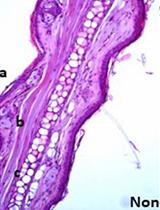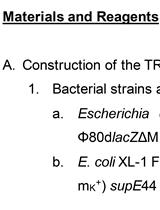- EN - English
- CN - 中文
Infection of Human Hepatocyte-chimeric Mice with HBV and in vivo Treatment with εRNA
用HBV感染人肝细胞嵌合小鼠并用εRNA进行体内处理
发布: 2016年01月20日第6卷第2期 DOI: 10.21769/BioProtoc.1718 浏览次数: 7843
评审: Jia LiRamalingam BethunaickanAnonymous reviewer(s)
Abstract
Hepatitis B virus (HBV) can cause both acute and chronic disease in human liver with potentially high risk of cirrhosis and liver cancer. The host range of non-human primates susceptible to this virus is limited. Therefore, experimental studies with human hepatocyte-chimeric mice provide an invaluable source of information regarding the biology and pathogenesis of HBV. This section describes the protocol for infection of the human hepatocyte-chimeric mice with HBV. In addition, it has recently been shown that HBV replication can be suppressed by exogenous expression of viral epsilon RNA (εRNA; Sato et al., 2015), which serves as an encapsidation signal (Bartenschlager et al., 1992). Based upon this finding, we also describe the protocol for the liposome-mediated delivery of a plasmid encoding εRNA to liver in these chimeric mice.
Keywords: Hepatitis B virus (乙型肝炎病毒)Materials and Reagents
- 0.1-10 μl pipet tips (Thermo Fisher Scientific, catalog number: QSP# TF104 )
- 1-200 μl and 100-1,000 μl pipet tips (Corning, catalog number: 4845 and 4846 , respectively)
- 0.2 ml 8 strips PCR tubes and caps (NIPPON Genetics, catalog number: FG-028DC )
- 1.5 ml and 2.0 ml microcentrifuge tubes (Corning, catalog number: MCT-150-A and MCT-200-C , respectively)
- 15 ml and 50 ml centrifuge tubes (Corning, catalog number: 352096 and 352070 , respectively)
- 96-well fast plate (NIPPON Genetics, catalog number: 38801 )
- 1 ml syringe (MonotaRO Co., NIPRO Genetics, catalog number: 08-010 )
- Human hepatocyte-chimeric mice (PhoenixBio Co.)
Note: Chimeric mice are intravenously infected with 100 μl of HBV-C in saline solution (106 copies per mouse) derived originally from patient with chronic hepatitis (Sugiyama et al., 2006). - HBV (genotype C; HBV-C) (Dr. Yasuhito Tanaka, Department of Virology and Liver Unit, Nagoya City University Graduate School of Medical Sciences, Nagoya, Japan; Sugiyama et al., 2006)
- Sodium chloride (Nacalai tesque, catalog number: 31320-05 )
- YSK lipid (a pH-sensitive cationic lipid) (Faculty of Pharmaceutical Sciences, Hokkaido University, Sapporo, Hokkaido, Japan) (Sato et al., 2012)
- Cholesterol (Avanti Polar Lipid, catalog number: 57-88-5 )
- 1, 2-dimyristoyl-sn-glycerol methoxypolyethyleneglycol (PEG-DMG) (NOF Corporation, catalog number: GM-020 )
- Nuclease free-H2O
- Citrate buffer (12.5 mM citrate, 500 mM NaCl)
- pCpGfree-mcs vector (Invivogen)
- Primers for vector construction
pLKO.1 Fw SpeI: CCCACTAGTTTTCCCATGATTCCTTCATATTT
pLKO.1 Rv BglII: CCCAGATCTAAAATTGTGGATGAATACTGCC - TaqMan Universal PCR Master Mix (Life Technologies, catalog number: 4304437 )
Note: Currently, it is “Thermo Fisher Scientific, Applied Biosystems™, catalog number: 4304437”.
- Primers and probe for quantification of HBV DNA from HBV-infected chimeric mice sera:
Forward Primer: SF2: 5’-CTTCATCCTGCTGCTATGCCT-3’
Reverse Primer: SR2: 5’-AAAGCCCAGGATGATGGGAT-3’
Probe: SP2: FAM-ATGTTGCCCGTTTGTCCTCTAATTCCAG-TAMRA - MISSION® pLKO.1-puro Empty Vector Control Plasmid DNA (Sigma-Aldrich, catalog number: SHC001 )
- DNA oligo nucleotides (5’-3’)
Sense: CCGGTGTACATGTCCCACTGTTCAAGCCTCCAAGCTGTGCCTTGGGTGGCTTTGGGGCATGGACATTTTTG
Antisense:
AATTCAAAAATGTCCATGCCCCAAAGCCACCCAAGGCACAGCTTGGAGGCTTGAACAGTGGGACATGTACA - Oligo nucleotides (see Recipes)
Equipment
- Biosafety hood in a biosafety level 3 (BSL3) facility (HITACHI, catalog number: SCV-1303 ECIIB )
- Pipettes (PIPETMAN P2, P20 and P1000) (Gilson Scientific, catalog number: F144801 , F123600 and F123602 , respectively)
- qPCR adhesive seal (NIPPON Genetics, catalog number: 4Ti-0560 )
- Applied Biosystems Veriti Thermal Cycler (Life Technologies, catalog number: 4375786 )
Note: Currently, it is “Thermo Fisher Scientific, Applied Biosystems™, catalog number: 4375786”. - ABI StepOnePlusTM Real-Time PCR Systems (Life Technologies, catalog number: 4379216 )
Note: Currently, it is “Thermo Fisher Scientific, Applied Biosystems™, catalog number: 4379216”.
Procedure
文章信息
版权信息
© 2016 The Authors; exclusive licensee Bio-protocol LLC.
如何引用
Sato, S., Li, K. and Takaoka, A. (2016). Infection of Human Hepatocyte-chimeric Mice with HBV and in vivo Treatment with εRNA. Bio-protocol 6(2): e1718. DOI: 10.21769/BioProtoc.1718.
分类
微生物学 > 微生物-宿主相互作用 > 体内实验模型 > 哺乳动物
您对这篇实验方法有问题吗?
在此处发布您的问题,我们将邀请本文作者来回答。同时,我们会将您的问题发布到Bio-protocol Exchange,以便寻求社区成员的帮助。
Share
Bluesky
X
Copy link














